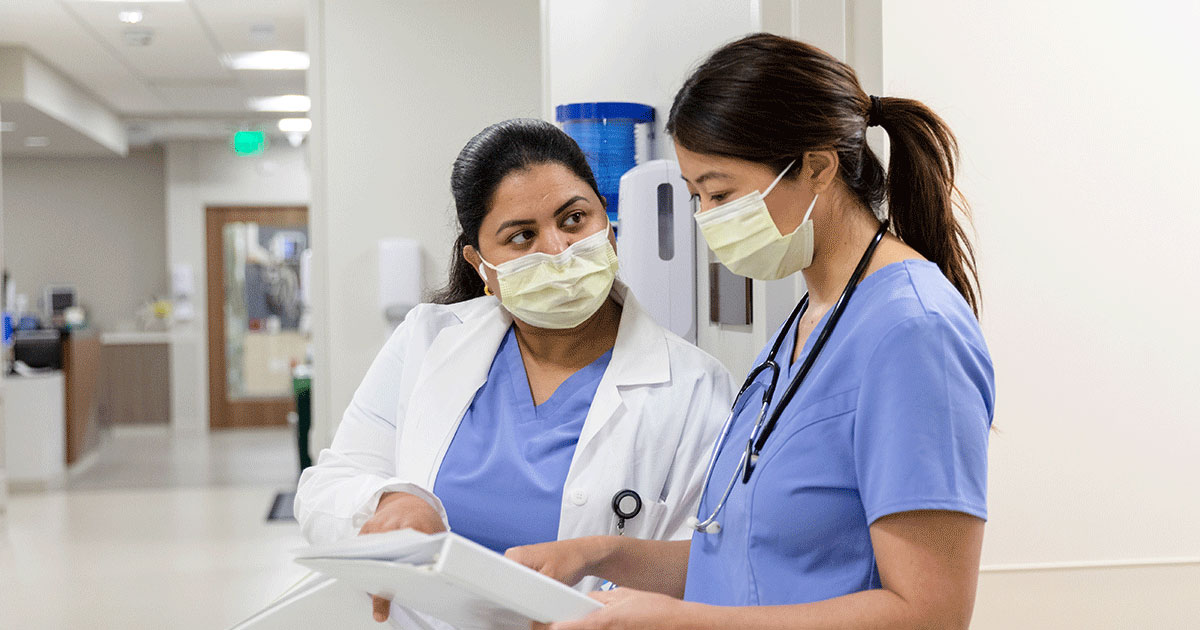HAI reduction: What’s in your toolkit?

By Medline Newsroom Staff | October 19, 2023
Like many health systems, FirstHealth of the Carolinas “was making strides and doing good” prior to the pandemic in terms of consistently keeping healthcare-associated infections (HAIs) to a minimum, said Jayne P. Lee, MPH, BSN, RN, CIC, FAPIC, First Health’s director of infection control/patient safety.
“And then came along COVID,” said Lee, with patients requiring higher levels of medical support and intervention, limited supplies, and ongoing staff shortages resulting in more temporary nurses and “less educational preparedness” among newer staff. Today, HAIs remain high across the nation with Hospital Safety Grade data from The Leapfrog Group showing a 60% jump in central line-associated bloodstream infections (CLABSIs) and a 19% increase in catheter-associated urinary tract infections (CAUTIs) in late 2021 and 2022, compared with pre-pandemic levels.
The result has been a renewed focus on support, education and standardized protocols—“a back to basics” approach—to help “reach and stay at zero” HAIs, said Lee, the featured speaker at the Medline-sponsored webinar during International Infection Prevention Week: “What’s in your toolkit for HAI reduction post-pandemic?”
Dedicating staff to the prevention of HAIs
Lee said the one decision that most helped her team during and after COVID-19 was appointing an infection preventionist, Nancy Chambers, DNP, RN, CIC, to solely oversee CAUTI prevention back in 2018. Her ongoing role includes the daily review of patients with catheters, working with nursing staff on appropriate and timely catheter removal, and implementing and enforcing external catheter processes and urinary retention protocols.

Nancy Chambers, DNP, RN, CIC, (left) and Jayne P. Lee, MPH, BSN, RN, CIC, FAPIC, presenting
CAUTI research at a recent APIC meeting
“Having that dedicated person made a huge impact,” said Lee, who more recently assigned an infection preventionist to exclusively oversee CLABSI prevention and protocols. “Nancy’s been very involved with the staff and patients, and I was able to keep her dedicated to that, even during COVID-19. Having that person who (staff) see every day has made the most impact.”
Chambers says “just in-time reinforcement” is the best way to identify and fix CAUTI-related procedural issues, especially for traveling or temporary staff. “They know—‘She’s going to tell me the same thing if I don’t fix these issues today.’”
Susan Baker BSN, RN, at Allegheny General Hospital in Pittsburgh, is one of five Lean quality coaches at Allegheny General. In 2017, she recruited one nurse from each of the 16 inpatient units to provide recommendations on HAI prevention and to implement and oversee best practices, which continued throughout the pandemic, also helping to limit infection.
Utilizing clinical assessments
Despite implementing infection prevention protocols and oversight before and during the pandemic, FirstHealth and Allegheny General looked to Medline’s Urological Solution and Vascular Access Health Solution clinical assessments to help reverse HAIs.
“Medline brings in reps with clinical expertise” to review and assess staff practices and protocols, said Lee. Staff and leadership were interviewed, store rooms were assessed, and “then we looked at every single line or Foley in place.”
“Having the partnership with Medline was helpful because we have a person we can call. Our clinical person is readily available to us if we have an issue or concern. The assessments provided us with the tools, and we have follow-up assistance.”

Jayne P. Lee, MPH, BSN, RN, CIC, FAPIC
Director of Infection Control/Patient Safety
FirstHealth
For example, while 100% of patient drain bags were located below the bladder, only 28% were without dependent loops; and while 83% of catheters were properly secured, only 7% of bed sheet clamps were engaged.
“We were actually able to see what our problems were—dependent loops and use of sheet clamps—and able to focus our energies and education there. What we realized is that we need to get back to basics on our catheter care and maintenance,” said Lee. Medline posters helped to reinforce these protocols.
In addition, central lines were assessed, revealing the need for dressing change protocols.
Lee specifically called out Medline’s education kits—including cards, flyers and posters—which allow infection preventionists and nurse leaders “to pick and choose what’s right for your staff.” Medline University, she said, offers training courses, including “really wonderful modules that staff can listen to.”

CAUTI-prevention reminders at FirstHealth
“Having the partnership with Medline was helpful because we have a person we can call,” said Lee. “Our clinical person is readily available to us if we have an issue or concern. The assessments provided us with the tools, and we have follow-up assistance.”
The overall CAUTI trend line continues to decline at FirstHealth, decreasing from 16 CAUTIs in 2018 to 5 in 2022. The CLABSI rate, which increased during the pandemic, is also coming down.
A refocus on ‘the little things’
Allegheny General’s first Medline clinical assessment was in May 2021.
“It was the little things that we missed,” said Baker of the assessment results, including that “tons of people were not using securement devices” or Foley kickstands. “We spent time with Medline. We did a lot of education around that.”
Later that year, only two Foleys were without a securement device at Allegheny General, down from a typical monthly rate of 100. There’s also a lot more discussion and consideration on whether or not a Foley is necessary, said Baker.
Allegheny General also created a hospital-wide “CAUTI Collaborative” that includes “engaged” physicians who are committed to the process and outcomes, and at the hospital level, a “CAUTI Championship Team” that has a designated time at the daily huddle.
“We look at every CAUTI that we had the last month,” said Baker. “We dig down into the nitty gritty. Sometimes, it’s a matter of – ‘Why did the physician order that?’ Often patients will complain of urinary urgency after the Foley is removed. This can be a normal occurrence after a Foley is removed. Without any other symptoms (leukocytosis, fever), waiting for 48 hours will often resolve the issue. That’s where we sometimes need our doctors to get involved. Don’t order a culture. This is a normal response. Often times you do have a slight infection and your body may improve on its own. We’re also looking at antibiotic use.”
“We don’t know what we don’t know, so education is huge.”
Susan Baker, RN
Allegheny General Hospital
In 2017, Allegheny General had 88 CAUTIs a year. In 2022 that number dropped to 25, and this year, to date there have been just 17.
“When I’m out talking to staff, and the teams that I coach, I say: ‘You guys should be so proud. These (improvements) are directly the result of your care,’” said Baker.
Baker said it’s important to reinforce the “value” of day-to-day care in relation to patient outcomes. “We need to educate and explain the value of it. We don’t know what we don’t know, so education is huge.”
The ‘path is not always straight’
Despite the successes, Lee says her team continues to “struggle” with HAIs post-pandemic. “It’s a path and that path is not always straight. We are moving in the right direction, although sometimes we feel like it’s one step forward, two steps back. Our goal is to reach and stay at zero HAIs,” a goal that her team met post-COVID-19 – for two years in the hospital’s critical units.
“We can’t get discouraged,” she continued. “Remember that every infection that we prevent is a patient who did not get an infection – it’s a friend of yours, it’s a colleague who did not get an infection.”
“When you know what the right thing to do is, it’s really hard not to do that,” said Baker. “I think that most nurses have the same type of compass.”
Learn more about Medline’s 3-zone strategy for infection prevention.
Learn more about Medline University’s Urological Solution and Vascular Access Health Solution education programs.
Read related articles:
Medline Newsroom Staff
Medline Newsroom Staff
Medline's newsroom staff researches and reports on the latest news and trends in healthcare.


